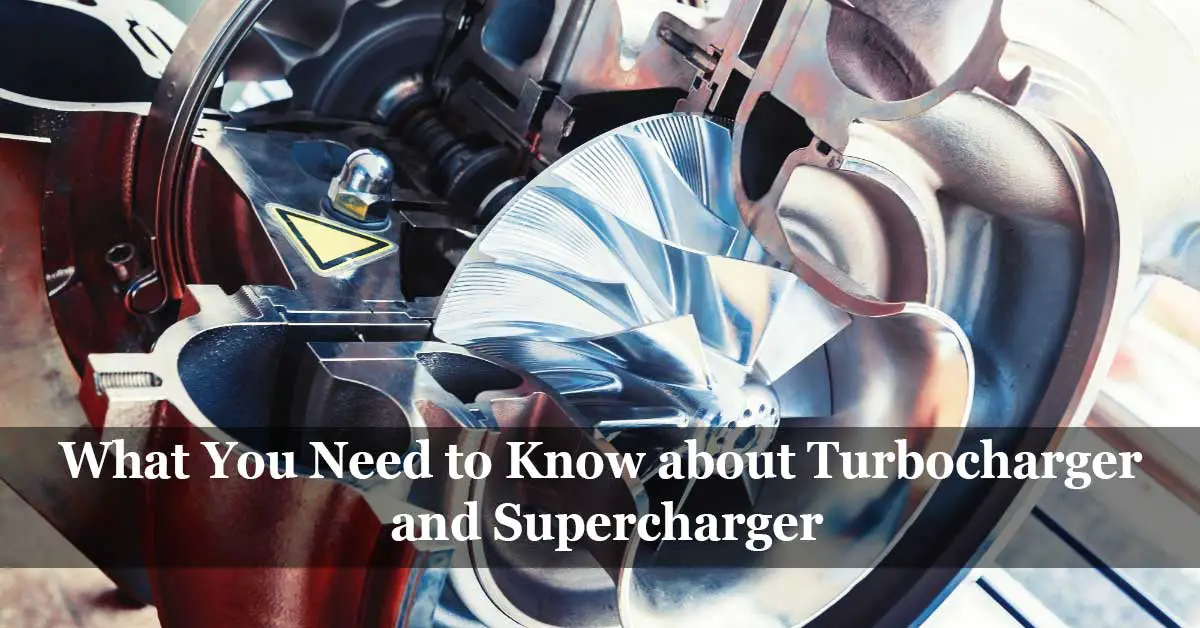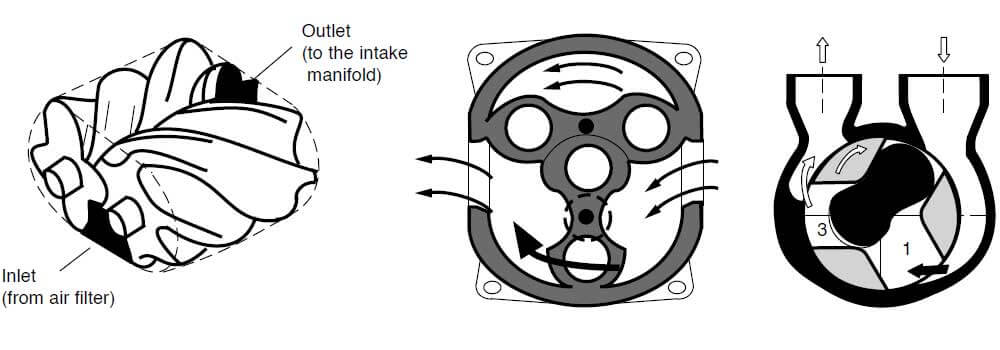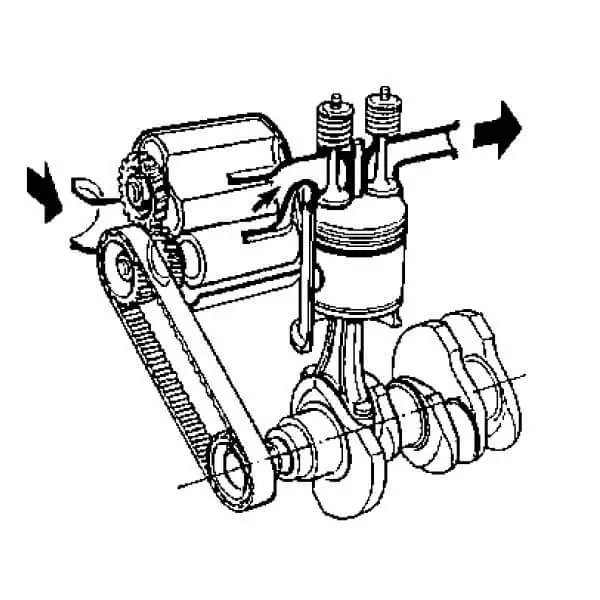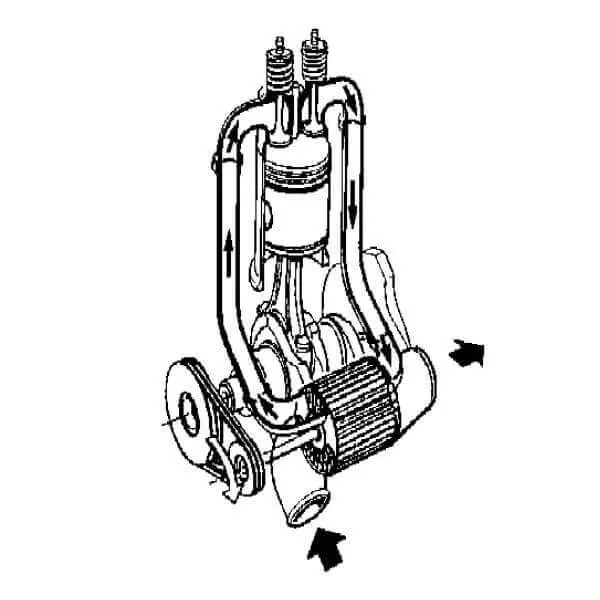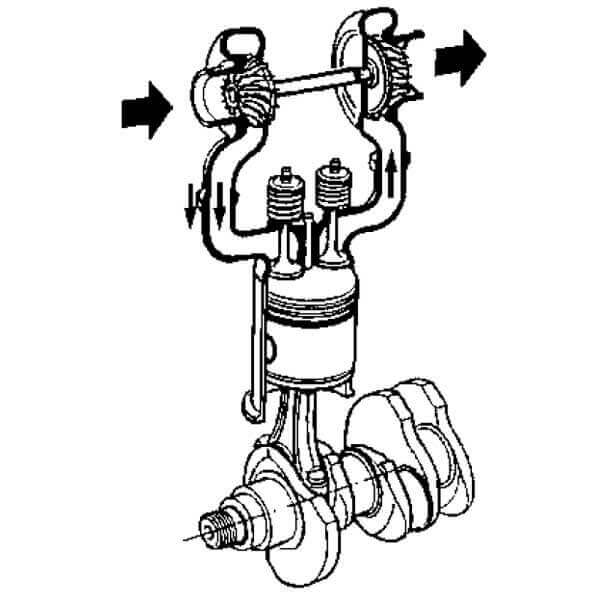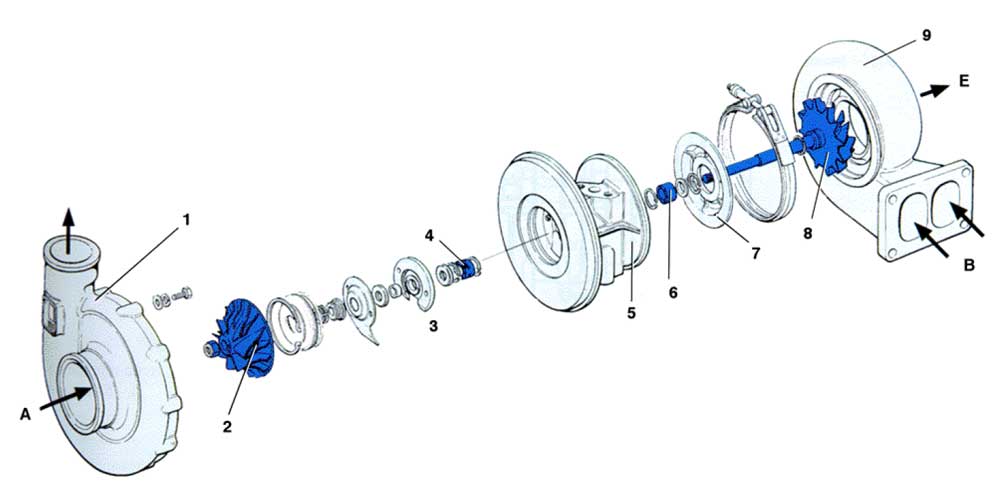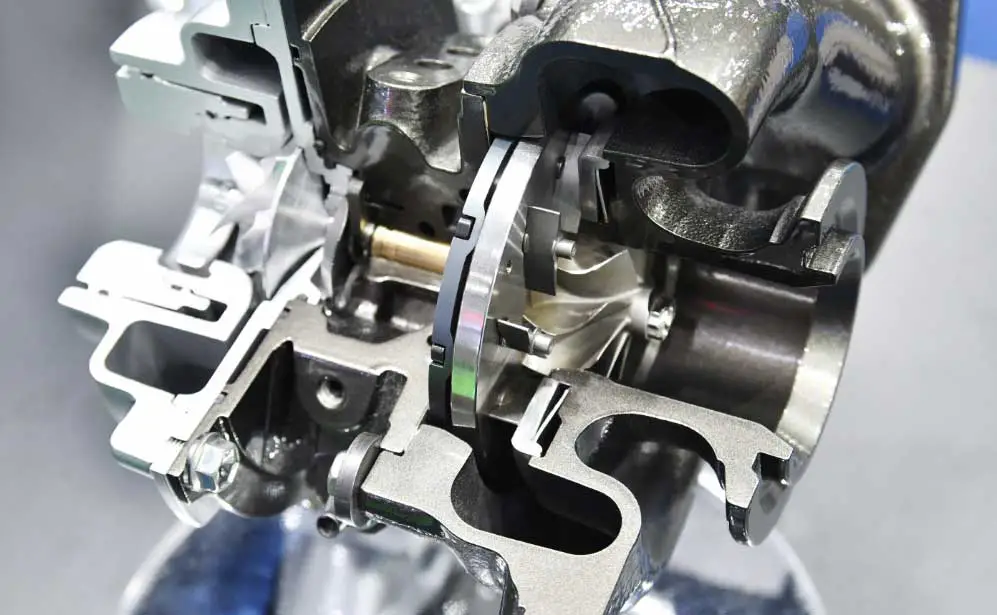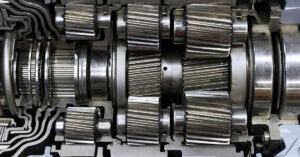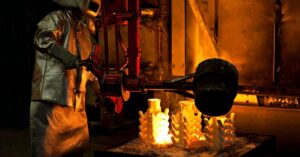Turbocharger is the device that charges the air centrifugally into the engine cylinder at a higher pressure and higher density than atmospheric pressure, the higher density air results in burning a greater mass of fuel and produce a higher engine output. Hence, the turbocharged engine can deliver higher output power than a naturally aspirated engine of equal size.
Supercharging is the process to improve the performance of internal combustion engines by increasing the air pressure inside the engine to burn a more considerable amount of fuel and boost engine output. There are several common supercharging types such as positive-type, centrifugal or pressure-wave compressors. The most common is the centrifugal compressor, which is also known as a turbocharger.
What Is Supercharging?
An engine develops mechanical energy by converting the thermal energy contained in the fuel, however, the transformation is usually incomplete since certain losses are unavoidable. On average, an engine (Diesel or Gasoline) loses 30% to 35% energy as heat loss in exhaust gases. The large losses are caused by the exhaust gases, which escape at a temperature and a pressure much higher than the atmospheric temperature and pressure.
Recovering the high lost energy present a potentially economical source of power, and supercharging was the solution to recover some of the loss.
The supercharging technique enables artificially increasing the amount of air introduced into the cylinder to values superior to the cylinder’s volume and thus increases the engine’s intake pressure. These increases cause the engine to burn a larger amount of fuel and increase engine power output and efficiency.
The increase in air density and pressure increases the combustion duration, resulting in increases in the work per cycle. The engine Mean Effective Pressure (MEP) increases and cause an increase in power output without a change in the engine cylinder dimensions or RPM.
What are Supercharging Types?
Three common types of supercharging devices that have the same objective but they are different in design; the three types are:
- Mechanically-driven positive-type compressor.
- Pressure-wave compressor, also known as pressure exchanger compressor or Comprex system.
- Centrifugal compressor provided with a turbine driven by exhaust gases (turbocharger).
Mechanically-driven Positive-type Compressor
The positive-type compressors are engine driven on which enables pressure build-up once engine acceleration starts. This supercharging method provides high torque at low speed; however, the drawback is the high power consumption at high engine acceleration with limited airflow.
A combination of a positive-type compressor with a turbocharger is common; this combination provides high torque over the whole speed range.
Comprex System “Pressure waves”
The Comprex system uses the pressure wave generated by a brief contact between the exhaust gases and the intake air in the rotor cells utilizing the pressure difference. This system’s advantage is that it provides a much lower low-speed response time compared to the conventional turbocharger while maintaining a comparable performance at high speed.
Centrifugal Compressors “Turbochargers”
Centrifugal Compressors are the most common supercharging method; they are also known as turbochargers. Turbochargers have been in use for a long time on high-speed engines and smaller cubic capacity engines. The advantage of this system that it is driven by the kinetic energy of the exhaust gases as well turbochargers are small in size and thus their weight is low.
Turbochargers are currently the most advanced supercharging mode, and there are still good prospects as to its future.
Interesting article: Types of Carburetors | What is a Carburetor?
Turbocharger vs Supercharger
As previously mentioned, Supercharging is the process of increasing the air pressure and density inside the engine to burn a more considerable amount of fuel and boost engine performance; the turbochargers are one type of supercharging devices.
The difference between a turbocharger and a conventional supercharger is how the device is driven. The turbocharger consists of a turbine that spins by the exhaust gas pressure; hence, turbochargers are driven by the engine’s exhaust gas. The supercharger is the supercharging device that is mechanically driven. The superchargers are connected mechanically by a belt, gear, shaft, or chain to the engine’s crankshaft.
Turbochargers are less responsive, especially at engine low-speed; although turbochargers do not place a mechanical load on engines, it creates back pressure on the engine. The superchargers place a mechanical load on the engine; the mechanical load reduces engine output power.
Turbocharger and supercharger combination in one engine is common; combining the two systems provides high torque over the whole engine speed range. The turbocharger and supercharger combination in one system is called the Twincharger system.
Turbocharger Parts and Components
The turbocharger comprises a compressor and a turbine mounted on a shaft; the compressor draws up ambient air and discharges it upstream from the engine intake valves. The turbine is actuated by the exhaust gases, which are still under pressure at the engine outlet; it drives the compressor into the rotation. Recovering part of the exhaust gas energy.
The turbocharger inertia is low, and thus the turbocharger must run at very high speed; gas compression increases gas temperature, which significantly reduces filling. To overcome the high gas temperature, an air cooler may add to the intake system.
A regulation system included limiting the supercharging pressure to reduce the turbine’s rotating speed and the compressor.
A turbocharger consists of the following elements:
A. Intake air.
B. Combustion gas.
E. Exhaust.
- Compressor housing – it is the cold section in which the ambient temperature air is compressed.
- Compressor wheel – draws up ambient air compresses and discharges it upstream from the engine intake valves.
- Stop.
- Bearing sleeve.
- Central housing – the carrier that includes various elements required for the two sections’ correct operation.
- Bearing sleeve.
- Thermal protection cover.
- Turbine – is actuated by the exhaust gases that are still under pressure at the engine outlet drive the compressor into the rotation, recovering part of the exhaust gas energy.
- Turbine housing – is the warm section that receives the exhaust gases to drive the turbine.
Compressor and turbine wheels are fitted on the same shaft carried by bearings; the assembly is known as Rotating sub-assembly (Rotor).
A layout of 2-stroke marine diesel engine turbocharger
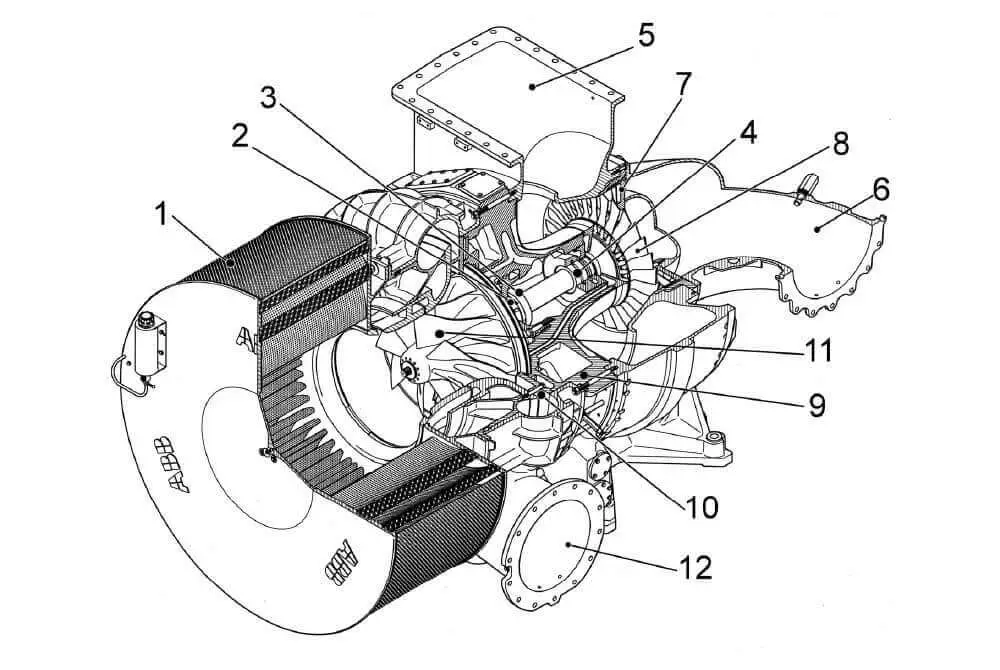
1. Filter silencer.
2. Radial plain bearing.
3. Thrust bearing.
4. Radial plain bearing.
5. Gas outlet casing.
6. Gas inlet casing.
7. Nozzle ring.
8. Turbine wheel.
9. Bearing casing.
10. Diffuser.
11. Compressor wheel.
12. Air outlet casing.
Applications of Supercharging
The highly diversified supercharging applications can cover power levels ranging from a few tens to several thousands of kilowatts. The main applications are:
- Automobile, heavy trucks, public works equipment, agricultural equipment.
- Railroad traction.
- Oil rigs.
- Standard emergency electric generators and diesel alternators.
- Marine propulsion: fishing boats, tug-boats, yachts, etc.
- Military: tanks, all-terrain vehicles, submarines, surface ships, etc.
- Light aircraft.
Advantages and Drawback of Supercharged Engine
Advantages
The advantages of a supercharged engine compared with its natural-aspiration version are:
- Higher-end of compression pressure, which means a higher cycle efficiency, hence higher useful power.
- A supercharged engine is 30 to 40% more powerful than a naturally aspirated engine.
- More efficient combustion than in atmospheric engines due to the larger amount of air is admitted into the cylinder since this air is compressed.
- There are fewer non-burned residues and pollutants, thus fewer fumes since combustion is more efficient.
- Fuel saving (5 to 10%) due to recycling the hot exhaust gas energy.
- Lower noise level through the leveling of the exhaust sound waves. The turbocharger acts as a very efficient exhaust muffler and, to a smaller extent, as an intake muffler.
- Increase of the ‘response time’ of the supercharged engine; high torque at low speed.
- Reduction of the engine size (reduced from 15 to 20%) for equal power means a better weight/power ratio.
Drawbacks
The drawbacks of a supercharged engine as compared with its natural-air suction version are:
- The increase of the rotational speed causes higher mechanical and pneumatic losses that affect the timing diagram and consequently the camshaft and the engine smoothness at low speeds when driving in town. As a consequence, engine wear is higher.
- The increase of the compression ratio is limited by the quality of the fuels.
- More expensive maintenance and higher cost price.
Install Turbocharger on Any Engine
How to Convert any Engine into a Supercharged Engine?
Supercharging will directly influence the load per unit of area of the structure, both from the thermal and mechanical points of view. It is therefore recommended to consider the characteristics and essential points as described below:
- The primary fluid systems of the engine should be capable of circulating at the highest flowrates.
- Air, oil, and, to a smaller extent, fuel filtration should be reinforced.
- The size of the exhaust line should enable the discharge of the highest flow per unit of gas.
- The cylinder head, moving assemblies (pistons, pins, connecting rods, and piston rings), crankshaft, and crankcase should be carefully studied as to their capacity to withstand the heavier loads.
- The camshaft’s geometry that provides the so-called intake – compression – combustion/expansion and exhaust stroke timing diagram will probably be restudied; valve lifts following the compression ratio, and the shape of the piston heads will be restudied too.
- Particular attention should be paid to the cylinder head gasket.
- The injection devices’ setting will be of paramount importance since it governs the power and torque generated by the amount of fuel supplied to the cylinders.
- The setting parameters will be the pump flow rate and setting (static and dynamic injection advance) and the injector calibration.
- More important modifications may necessitate to choose pump pistons of larger diameters and faster cam contours (case of the inline pumps), for a law of flowrate depending on the rotational speed and therefore on the fuel filling rate the most adapted to the specifications.
- A specialist will select the turbocharger, who will endeavor to find the best compromise between air and fuel over the range of speeds open to the engine.
- Engine cooling: the radiator and its aerothermal characteristics, the pump flow rate capacity, and the system’s content will be checked and readapted if necessary.
- Engine lubrication: the pump capacity and the circuit content will be reevaluated.
- As motorizing alone cannot render the vehicle performing, the clutch, gearbox, drive axle, transmission shafts, suspensions, and the braking system should be checked, without forgetting that satisfactory endurance tests are the best warranty of safety in this type of conversion.
How to Improve the Performance of a Supercharged Engine?
Usually consists of increasing supercharging by increasing the air’s low pressure to the intake valve to high pressure.
Thus, it will be necessary to optimize the fluid supply and discharge systems by reducing the bends and the head losses and improving the surface conditions.
- The heat exchanger’s action on the supercharging air will be highly profitable; it is probably the priority of priorities in this field.
- Increasing the injection pump flowrate and changing the fuel injection system’s various parameters come within the priority actions to be taken by the specialists.
- The modification of the compressor aerodynamic specification and the turbocharger turbine and the turbomachine settings’ correction will be done by personnel having sound knowledge of the equipment concerned. Although costly, improving the engine’s permeability at the cylinder head and camshaft levels will positively contribute to increasing the performance as required.
- Increasing the oil system’s capacity with the addition of a radiator (or air/oil exchanger) will be considered if no provisions have been made for it. Endurance tests will be recommended to check the behavior in service of a so converted mechanical assembly, especially regarding the strength of the cylinder block/cylinder head assembly under the effects of higher maximal combustion pressures resulting from supercharging.
Reference:
- Wikipedia – Turbocharger.
- ABB Group – various publications.

